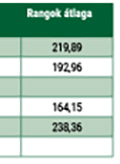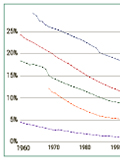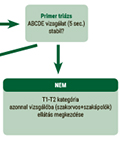The eLitMed.hu medical portal uses computer cookies for convenient operation. Detailed information can be found in the Cookie-policy.
Journal of Nursing Theory and Practice - 2019;32(02)
Content
[Attendace of the wounded: A historical overview from antiquity to South Slavic war ]
[A series of care history reviews can be found in the journals. However, there have been few publications about the military aspect of the attendance of the wounded, so I found it important to show how it has changed, how it has developed, what has become a medical field nowadays and what its significance can be today. As a medical officer I would like to present the historic milestones of prehospital battlefield trauma from antiquity to Vietnam and South Slavic war. ]
[Smoking habits and predicting factors of smoking cessation among health care workers ]
[The aim of the study: The aims of the study were to determine the prevalence of smoking and identify factors that predict smoking cessation motivation among health workers. Material and method: Cross-sectional, self-reported survey filled out by all healthcare workers of Jósa András Teaching Hospital. Statistical analyses were performed by chi-square analysis and Mann-Whitney tests. Results: Of all responses (N =1561), 29.9% reported actively smoking, 52.0% smoked between 11-20 cigarettes a day. A total of 20.4% had tried to quit smoking before. Those who would not participate in a smoking cessation program outweighed those who favored participation (43.2% vs. 35.6%). Significant relationships were found between the technique of smoking cessation and intent to quit smoking (χ2 = 7,73; p = 0,02) and between smoking cessation and stress induced smoking habits (r = 0,1; p = 0,12). Those not wanting to quit smoking appraised smoking as a social link to others (Z = -2.34; p = 0,02). Conclusion: Besides putting a stronger emphasis on smoking cessation and on negative health effects of smoking, nurse managers should promote working environments where improvement in stress management and collegial relationships will minimize the need for smoke related groups.. ]
[A Systematic Review of nurses knowledge of Incontinence-Associated Dermatitis ]
[Background: Due to the growing incidence of incontinence, Incontinence-Associated Dermatitis (IAD) is one of the most important health problems nowdays. The most significant challange is the differentiation of IAD and ulcer pressure. Missclassification in practice causes suboptimal prevention and therapy. Thus, in order to provide optimal care, nurses need to be able to properly differentiate between the two illnesses. Objectives: The airm of this analysis was to identify how nurses can classify IAD from ulcer pressure, and how differentiation could be taught to nurses. Method: A systematic review was done wih ’pressure ulcer and ’classification’ and ’nurse’ search words using 3 databases, the Pubmed (NLM), the Science Direct and the Web of Science as basic sources. We relied on articles that were published before September 2018. From the total of 1268 records 7 studies met all the inclusion and exclusion criterias and were chosen for analysis. Results: We counted weighted arithmetic from the results of the studies. In total 4062 nurses participated in the clinical trials. Their weighted mean score was 33,2%. 2132 nurses got some types of education, The weighted mean score of their pre-test was 37%, while their post-test reached 66%. Conclusion: Differentional diagnosis between pressure ulcers and IAD is complicated. However, studies all agree that education in this field produces good results.. ]
Socioeconomic status and health status: mortality and morbidity
There is no situation that the individual’s socioeconomic status (SES) play a huge role in the individual’s health outcomes and the health care they receive. Socioeconomic status is mostly measured by education, income and occupation. People of higher SES tend to have more knowledge on health and health behaviours, and that determined their accessibility, acceptability and affordability of health care services. Arpey et al 2017, opined that people of lower SES are more likely to have worse self-reported health, lower life expectancy, and suffer from more chronic conditions when compared with those of higher SES. In this study, I want to analyse the relationship between socioeconomic status and health status considering mortality and morbidity among people of lower SES and higher SES using current literatures review. Base on this study it is clearly understood that there is a clear disparity in health status between lower socioeconomic status and higher socioeconomic status population. This health inequality is as a result of differences in economic, social and cultural factors. Health inequalities is avoidable and unfair because it is as a result of an unjust distribution of the underlying social determinants of health such as, unequal opportunities in education and/or employment which are the core determinants of persons socioeconomic status. Therefore, in order to reduce the inequality in health among higher and lower SES group, there should be equal distribution and opportunity for both groups to access education and employment.
[What does a triage nurse do? ]
[Emergency patient care department problems have recently come to the fore, especially in terms of waiting times and triage activity. It is still not entirely clear to society what is the triage system is, what is it good for, and who is the person, who applies the classification of patients. There is countless conflicts and tensions in the process of health services due to lack of knowledge. In Hungary, emergency departments play a prominent role in healthcare. Increased patient flow is a global problem, and therefore a distinction should be made between the „door to physician time” of the patients. The so-called grading system (triage) has been developed for this purpose, during which an experienced qualified nurse will measure and assess the patient’s condition as quickly as possible on the basis of different criteria. In my communication, I present the triage activity, the use of the classification system, what the triage nurse is doing, by comparing two cases. ]
1.
Clinical Neuroscience
Is there any difference in mortality rates of atrial fibrillation detected before or after ischemic stroke?2.
Clinical Neuroscience
Factors influencing the level of stigma in Parkinson’s disease in western Turkey3.
Clinical Neuroscience
Neuropathic pain and mood disorders in earthquake survivors with peripheral nerve injuries4.
Journal of Nursing Theory and Practice
[Correlations of Sarcopenia, Frailty, Falls and Social Isolation – A Literature Review in the Light of Swedish Statistics]5.
Clinical Neuroscience
[Comparison of pain intensity measurements among patients with low-back pain]1.
Clinical Neuroscience Proceedings
[A Magyar Stroke Társaság XVIII. Kongresszusa és a Magyar Neuroszonológiai Társaság XV. Konferenciája. Absztraktfüzet]2.
3.
Journal of Nursing Theory and Practice
[A selection of the entries submitted to the literary contest "Honorable mission: the joys and challenges of our profession" ]4.
Journal of Nursing Theory and Practice
[End of Life and Palliative Care of Newborns in the Nursing Context]5.
Journal of Nursing Theory and Practice
[Aspects of Occupational Health Nursing for Incurable Patients ]







